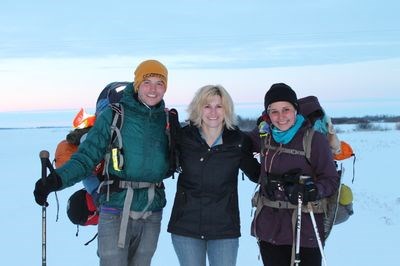Having Sarah Jackson pass through Canora last week during her quest to see Canada while hiking the Trans Canada Trail is still very new but more trail enthusiasts are expected as 2017 approaches, said Kristen Gabora of Canora, co-ordinator for the Saskatchewan portion of the trail.
Right now, she is likely only the third person to attempt the feat, Gabora said. However, many have passed through Canora while hiking or cycling significant portions of the trail.
The goal is to have the full trail connected in time for 2017 when the trail will celebrate its 25th anniversary and the country will celebrate its 150th anniversary, she said. Great strides have been made in the last couple of years and the pace will accelerate in the coming years.
When Gabora became the co-ordinator in November of 2013, only 34 per cent of the trail was complete in Saskatchewan. That figure increased to 71 per cent last summer and it will be substantially higher when calculations are made this summer.
As of June of last year, the three provinces with the most trail to connect were: Nova Scotia, 38 per cent done; New Brunswick, 61 per cent done; and Alberta, 59 per cent done.
In Saskatchewan, a lot of rural roadways were used, and not highways. As a hiker, Jackson said that was what she liked about Saskatchewan. The rural roads allowed her to see a side of Saskatchewan she never would have seen from the highway. One of her most memorable experiences was cross the North Saskatchewan River at the Wingard Crossing. That crossing is normally done in the summer months by ferry, but she was able to make an ice crossing.
Gabora referred to Jackson as “a true role model for youth. She’s doing something outside the box and the beauty of what she’s doing is that she’s doing it for herself.”
Gabora met with Jackson and her hiking partner on this stretch of the trail, Stephan Wynnyk, just as they left Canora. They had intended to camp overnight by Ehrlich’s Bridge on the bank of the Whitesand River.
When Jackson and Wynnyk arrived in Canora on March 21, they said that was Day 184 of her trip. She tries to hike at about five kilometres per hour for four to 10 hours per day. She thinks the longest stretch she covered in one day was 43.5 kilometres. She has GPS tracking on her so her parents will always know where she is.
Wynnyk, who lives near her parents in Calgary, decided to join her on the section of the trail from Cochrane, Alta. to Winnipeg.
Jackson said she tries not to have any expectations before reaching a place. She likes to experience it. She began in Victoria and plans to plant her foot in the Atlantic Ocean before the first snowfall of next winter. Along most of the way, she has had family members or friends walk with her. For the final leg, she hopes to have her parents join her – and they can offer a ride back.
People have been very interested in her hike and many strangers have stopped along the roads to ask what she’s doing. She did start a website where she posts entries about where she has visited.
It is the people that have been the most amazing, she said. Everybody has been so welcoming and many have offered a warm place to spend a night.
Every day is so different and she has experienced many places she never knew about. “Every step east is exciting – it’s all new.”
The provincial and national parks are beautiful and the Qu’Appelle Valley has to be the most beautiful site in Saskatchewan, Jackson said. Saskatchewan is definitely not as flat as most people are led to believe.
She noted that her backpack was usually about 60 pounds when it was packed in the morning, but by evening as the water and food is used up, the pack is a lot lighter. In summer, she concentrated on carrying a lot of water for the day’s hike, while in winter, it is more protein bars.
Jackson said she prefers the rural hiking as urban hiking is always a hassle. In the rural areas, it is possible to set up camp almost anywhere.
As she moved east, Jackson said what she can’t wait to see most is the Canadian Shield and the Great Lakes.



